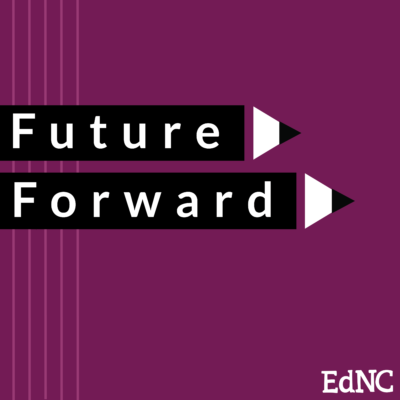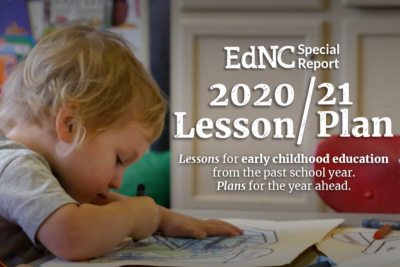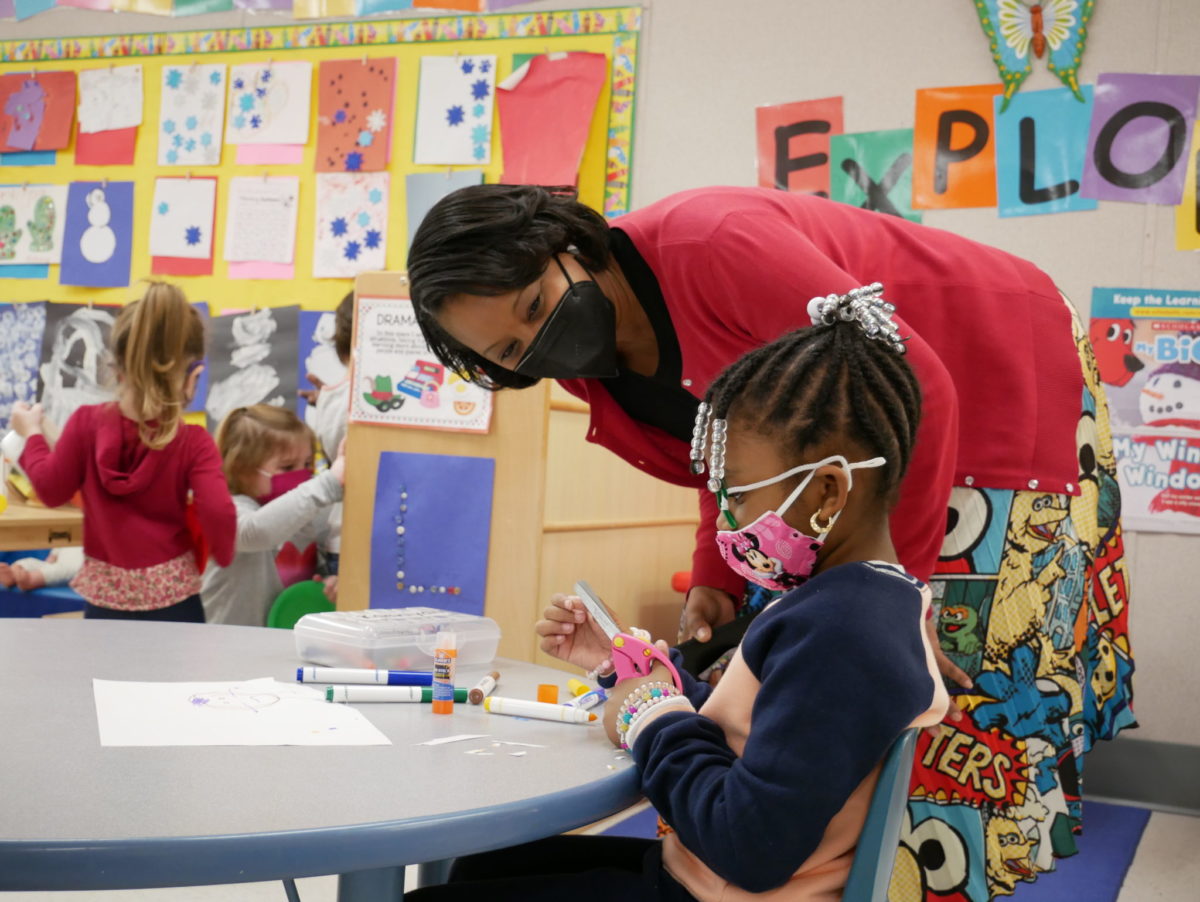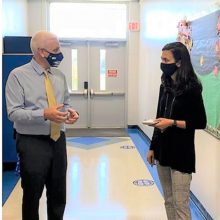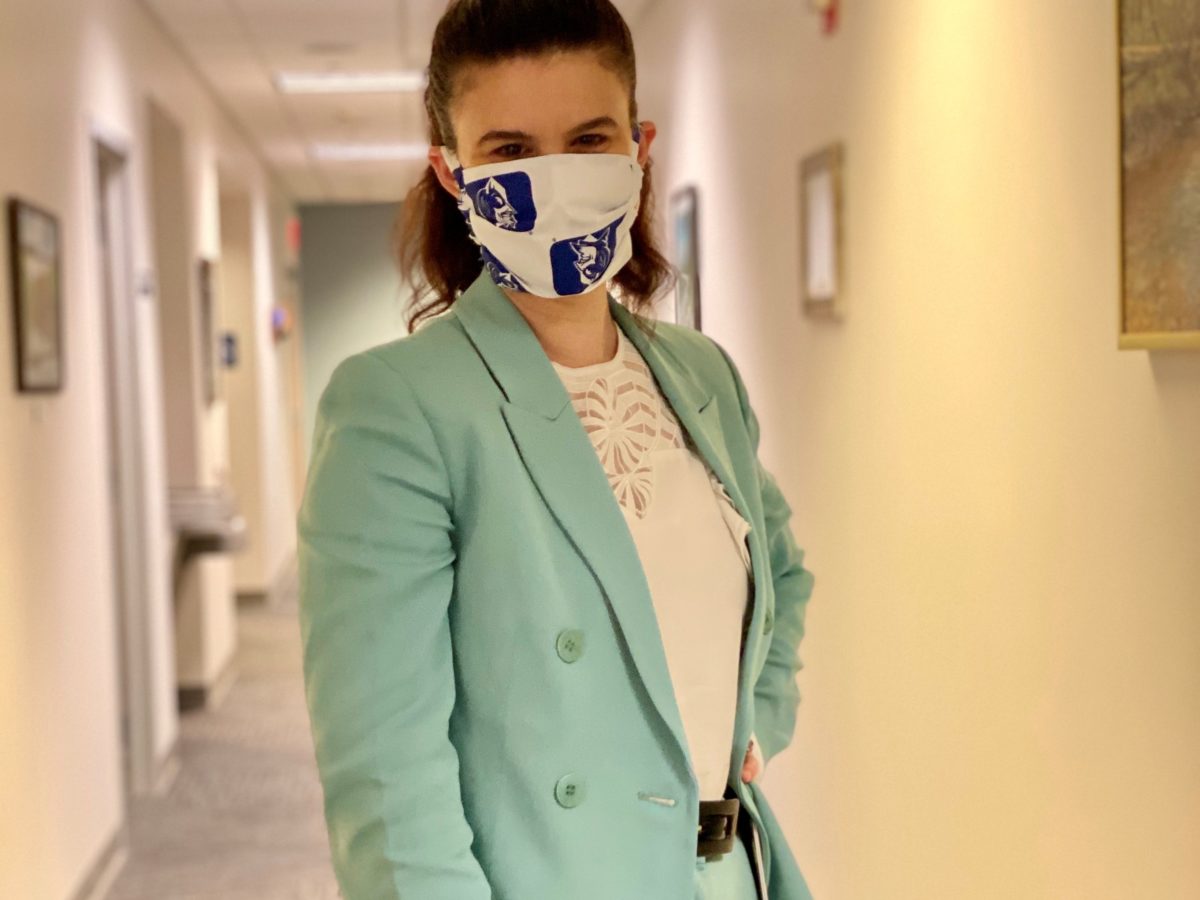
|
|

Lessons from the past school year. Plans for the year ahead. In this special report, EdNC looks at how the pandemic impacted education and what that means for the future. Read the rest of the series here.
What was it like to be a state education leader during an unprecedented school year? We interviewed three of those leaders — Rebecca Planchard, Eric Davis, and Thomas Stith — to hear their reflections on the pandemic and thoughts about the future of education.
Below is our interview with Rebecca Planchard, senior early childhood policy advisor with North Carolina’s Department of Health and Human Services (DHHS). During the pandemic, Planchard coordinated the department’s K-12 COVID-19 response and guidance and worked as a liaison with the state Department of Public Instruction (DPI). We discussed her toughest and brightest moment of leadership from the last year, what’s bringing her hope right now, and more.
This interview, which was held in April 2021, has been edited for length and clarity.
Sign up for Early Bird, our newsletter on all things early childhood.
Sorrells: Will you introduce yourself and tell me a little bit about the roles you’ve played since March 2020?
Planchard: I’m Rebecca Planchard. My title is senior early childhood policy advisor. On March 14, 2020, I was tapped by Susan Gale Perry to lead our K-12 school closing work at the very beginning. So I was asked to come in to the emergency operation center the day that Gov. Cooper was going to issue his executive order and close schools. Unfortunately, my father passed away totally unexpectedly that day. And I got the news when I was in the emergency ops center. So I was off the grid for a month.
It was a fascinating time, because the reason Susan tapped me to pivot over from my early childhood work was because I have K-12 experience. I started my career as a bilingual kindergarten teacher. I served as a pre-K through sixth grade instructional coach. And I focused my master’s degree on education policy and municipal finance, a lot of which has to do with school finance. And so those were relationships that I had also started to build in the K-12 community in North Carolina with my early childhood work.
We knew that I could bring expertise in the K-12 field as it was becoming very clear what was happening in terms of COVID response. But because I was offline for about a month, it meant that some preliminary work of closing schools and figuring out how meals were going to be delivered happened without me. So that was the team hustling to just do incredible work for kids to make sure that folks were fed when schools shut down.
And then when I came back online in April 2020, the discussion was really, “OK, so what are we going to do? What is school operations going to look like during COVID?” And my role became coordinating for DHHS: What is our K-12 COVID response? How are we building out public health guidance? And then I ended up basically playing the role of our liaison between DHHS and DPI, and tag-teamed with the governor’s office and our State Board of Education, and ultimately with DOA [Department of Administration] as well in support of private schools as we got a little further down the road.
And all of us just played this incredibly collaborative, coordinating role to get guidance to teachers and school leaders and superintendents across the state.
Sorrells: That had to be fascinating to work across so many different departments, and you were right in the middle.
Planchard: I think I was set up for that inter-state agency work because our early childhood action plan was so interdisciplinary and so interagency. But I had never seen our K-12 system be so integrated in terms of state agencies coming together.
In my three years of being at the state, it’s the most collaborative we’ve ever been with DPI. And it has been just such an honor to to be involved in this work.
—Rebecca Planchard, DHHS
Sorrells: Continuing along that line of thought, what things do you think have gone well, either in K-12, early education, or just across the entire spectrum since March 2020?
Planchard: Looking back, North Carolina came out ahead of the game in terms of putting a stake in the ground around what our public health guidance was going to be for school operations. There really wasn’t comprehensive federal guidance at that point. And when we put out our Strong Schools NC guidance, and when DPI in tandem put out the Lighting Our Way Forward operational guidance, we were a model for other states who were very much in the beginning stages of thinking through what their requirements were going to be.
We came out of the gate saying, we are going to require social distancing, we’re going to require hand washing, we’re going to require surface cleaning, which was a big focus at that time, and then before school started, we really made the shift to masking being so important. Over time, it’s been incredible to see how our DHHS team, our epidemiology team, our leaders — they are constantly paying attention to what the data and what research are telling us. And we have adjusted our guidance accordingly over time.
That responsiveness and that ability to shift and recognize when you might need to get more or less stringent in terms of what your requirements need to be, or switch focus to what your recommendations should be — that, I think, is great. North Carolina has been flexible and also very strong on what our public health guidance is for our schools. And I know that at the very beginning, other states really looked to what we had put out as their starting place. So that’s pretty incredible, to think about the influence that North Carolina was then able to have for other kids elsewhere.
In the early childhood world, the fact that we did not close our child care centers — we kept them open — that is critically important. Our chief deputy Susan Gale Perry testified in front of the U.S. Senate on the importance of our child care infrastructure. And she highlighted how much work went in at our state level and how much work went in on the ground at the hands of our child care teachers and our site directors to keep their programs open for essential workers in those pivotal early months.
Our child care infrastructure did not close in North Carolina. And that is different from other states. And we are incredibly proud of that. But that took an incredibly coordinated, thoughtful effort by leaders like Susan at the state level to say, well, to do that we need to provide operational support to our programs to make sure that they can be fiscally sound. And we can eliminate parent fees, and we can provide bonus payments to our teachers to keep them afloat right now. We can increase the amount of subsidy that we provide.
All of that was North Carolina saying we really believe that child care must continue and must stay open. We believe child care is essential here.
—Rebecca Planchard, DHHS
And I think the key point in all of it, from birth through grade 12, is that North Carolina across the board took a coordinated, thoughtful approach in doing as much as we could to keep our birth through grade 12 classrooms open, knowing everything that we knew at the time. Looking back, it was just so much information coming out constantly. But I’d highlight communication efforts as a real bright point. We’d never had to communicate to every single early childhood educator in the state before, we’d never had to communicate like this to all of our education system, public and private, before. And we made it happen.
Sorrells: When reflecting on what the last year or so was like, is there anything in hindsight that you maybe would have done a different way?
Planchard: From a policy standpoint, I wish that we had had the infrastructure to provide bilingual supports from day one. And that we were better able to serve our non-English-dominant families, our non-English-dominant child care providers, our non-English-dominant students more clearly in terms of communication from the beginning. And we just did not have that infrastructure in place at the state level.
It has been so important for us to continue to build out our capacity not just to translate documents, but to actually think about our communication strategy for non-English-dominant speakers, particularly for Spanish speakers. Because if we could have done that from the very beginning, and been more able to communicate across linguistic and cultural lines, I think about the ethnic disparities that we saw over the summer of 2020 in particular, and if we had known more about the virus, and we had had more resources or infrastructure to support that kind of bilingual and bicultural communication, could it have made a difference? Maybe. We don’t know.
Being someone who has served our Hispanic communities in North Carolina and across the country, it’s particularly important to me. So that’s something that’s been on my mind and we’ve been thinking about as DHHS — how can we stand up lasting infrastructure at the state level to carry on the lessons we’ve learned about health equity beyond COVID? And when we think about health equity, it is completely integral to education. If a child’s not healthy, they can’t possibly learn at the same levels as their peers are in their classrooms.
So we have a Healthier Together effort that DHHS is leading. We’ve recently hired a director of Hispanic and Latino policy for the first time at DHHS. That is huge. And that is an explicit commitment to equity, not just in words, but in our staffing and in the the work that we are leading, and I’m incredibly proud of that. I just would have liked to see it happen earlier. But I’m glad with where we’ve ended up and where we’re headed.
Related Readings…
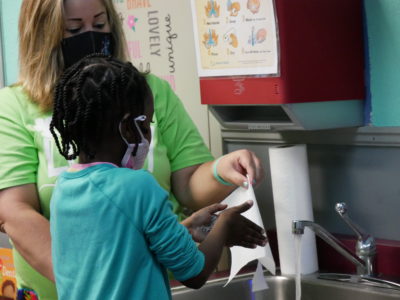
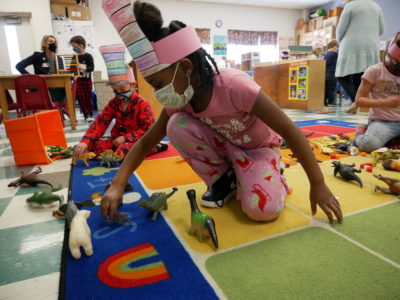
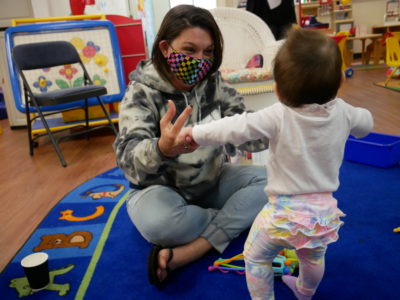
Sorrells: So now kind of looking ahead, how do you think early education and/or K-12 education will be changed in the future, for better or for worse?
Planchard: Tactically, North Carolina’s ability to collaborate between DHHS and DPI, I hope, will be a lasting type of relationship that’s been built. It’s now just a better understanding between the two agencies, that when we communicate at the highest levels, and we share priorities, and we share information, it’s just better for for kids, it’s better for teachers, it’s better for school leaders. So I hope that that continues, and I think it will.
I’m thinking about how we recognize now how much our school health teams do, and how essential they are for the well-being of our students, of our staff, and the role that they play in our communities as health messengers. They are trusted leaders in their communities about best practices and what to do to stay healthy.
It is our school nurses that have been conducting COVID tests on site for schools that have stood up testing programs. It’s our school nurses that were doing symptom screenings on campus. It’s our school nurses that are doing contact tracing. They have been doing so much. And I’ve had the honor and the pleasure of speaking to many school nurses, and they are exhausted and proud.
I think that the pandemic was an opportunity to really put a spotlight on our school health infrastructure and how much more we need to invest in it. Because again, that goes way beyond COVID. We think about our school health infrastructure as key opportunities for children to get vision screenings for the first time, to get glasses, to get, in some cases, dental screenings and hearing screenings. Our schools are a health care touch point for a lot of children. And I don’t know that that was in the public awareness as much as it is right now with COVID. But the more we invest in that system, the more our kids will get supported to be healthier. And that, again, is the foundation to really great learning outcomes.
In the early childhood world, what I want to be true is that we recognize that our early care and education teachers and program directors are completely underpaid for the essential services that they provide.
—Rebecca Planchard, DHHS
We are seeing just so plainly how essential child care is and how, right now, without ongoing infrastructural support, the system is not sustainable. And that has everything to do with salaries being too low and public funding not being enough.
It is not an industry that is being supported publicly for the true cost of how much it costs to take care of children, especially very young children. Taking care of babies in a really high-quality early care environment is expensive. And our kids deserve to have high-quality teachers who are ready to support them, who are not paid at actual poverty wages — $12 or less an hour is not an acceptable rate of pay for early childhood educators. I am proud that we have provided bonus payments to our educators because they kept showing up for kids. And I would love to see that continue to carry forward as a federal priority.
Sorrells: It might be hard to narrow it down to one, but what you would consider your main lesson learned from the events of the last year?
Planchard: It’s truly about communication. I think about my partner in crime at DPI, Jessica Swencki. She has played an incredible role in coordinating calls and in writing communications to school leaders. We were regularly planning: How are we going to get this information out to school leaders or superintendents?
Her eye on how to best speak in the education lingo and connect with superintendents and school leaders in a way that feels feasible for them has been really helpful for me in trying to bridge the gap between how we speak in our epidemiology team, how the CDC speaks about child and family health and well-being, and schools and education. When all of us are coming together in service of how can we best communicate the most important information to our education leaders — that makes the difference. That’s how we actually can operate schools safely.
You can have the best policies in the world. But if you’re not sharing that information in a way that is comprehensible and is understandable by your population, your policy ideas really don’t matter.
—Rebecca Planchard, DHHS
Sorrells: I’m interested in what it was like to be one of the people in these conversations and making these decisions at a time where things were changing by the minute. So, I’m curious to hear one tough moment of leadership and one bright moment of leadership as you think about what that was like.
Planchard: We respond to stakeholder calls. We responded to calls from teachers who were scared, or responded to emails from parents who were scared. There was a lot of fear. There still is fear about COVID, though we know so much more now than we did a year ago.
I think part of the original fears that our educators on the ground had and that our school leaders had was: Who are the folks making these big policy decisions that impacted our schools? And I want people to know that the people around the table were former educators. And that is so important.
I’m thinking about key people in every conversation who were able to say: OK, our school bus policies on social distancing, how is that going to play out? Or thinking through operationally, how do we take into account the health guidance from the CDC, how do we play that out into what’s going to work in most of North Carolina’s classrooms and for North Carolina’s kids? That comes from people who understand what it’s like to teach in public schools. Those were the folks who were around the table, all of us, and those who had not had the opportunity to be in the classroom, folks especially on our health side, they were ready to provide their input and they were open to feedback.
I think that those moments were really hard — responding to stakeholders who would assume that no one in education was involved. And I just wanted to say I can never fully understand what it’s like to be in your shoes right now, because I have not lived it. But I’ve been a teacher at least. And I’m here advocating as best I can for you, and so are all of these other former teachers at the table, trying our best. Those calls were hard. It was really, really hard, because I could understand the fear, and talking to educators was hard.
But I think that those are also the highlights, because it’s such an honor to have had the opportunity to be in this work at all. And I’m grateful that I have an education background and work for DHHS, and that I’ve been able to help us navigate between these two sectors that really before COVID were just not always speaking the same language. That’s been a huge honor.
I think publishing our Strong Schools NC guidance was a big day and was a day that I look back on as a real highlight because we were one of the first states to put anything out in terms of putting our requirements on paper. I was so proud of Gov. Cooper and Secretary Cohen for their leadership that day, in particular, of saying we want our schools to be open. We want to do that safely. We know some local communities are going to have to make the best decisions for themselves. But here is what our best thinking is right now with all the information we know. And that was not easy to do. And I’m super proud of what we were able to put together and what it’s been able to grow to over the past year plus.
Sorrells: As a final question, what is bringing you hope right now?
Planchard: Vaccines, and seeing our data. Getting to hug my godparents for the first time in over a year. That brings me hope. There is an end in sight. And we know so much more about COVID now. That brings me so much hope.
I want our vaccines to be approved for children under the age of 16. I want to see that vaccine availability expand. The vaccine data — our efficacy of our vaccines — that is giving me a ton of hope.
And hearing about great local leaders in our school systems who are providing information to their communities about why vaccination is important. It gives me hope to see principals and superintendents who are taking on the challenge of communicating about health locally, on top of everything else that our school leaders have to do.
They give me so much hope, those education leaders who say, yes, I’m going to take on more because I know that health equity is fundamental to educational equity. That’s what’s going to change outcomes for North Carolinians in the future. That’s what’s going to change outcomes for our kids, is keeping this health and education communication going. And when we have everybody vaccinated, that is critical to this future that we want to build together.
Recommended reading
